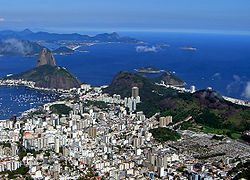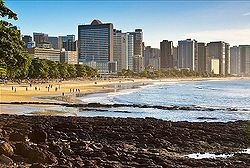- List of largest cities in Brazil
-
This is a list of the largest cities in Brazil. Brazil has a relatively high reported level of urbanization, with 84 out of every 100 Brazilians living in cities. The criteria used by the IBGE (Brazilian Institute of Geography and Statistics) in determining whether households are urban or rural, however, is based on political divisions, not on the built environment.
A town is any seat of a district (the lowest political division); a city is the seat of a municipality. Nowadays, the country has more than 5,564 municipalities.[1] About 81.3% of Brazilians live in an urban area.[2]
State capitals are usually also the largest city in their respective state, exceptions being Vitória in Espírito Santo, and Florianópolis, the capital of Santa Catarina; there are also non-capital metropolitan areas in São Paulo (Campinas, Santos, Paraíba Valley), Minas Gerais (Vale do Aço), Rio Grande do Sul (Sinos Valley) and Santa Catarina (Joinville & Itajaí Valley). Most of the non-capital large cities in Brazil are in the states of São Paulo, Rio de Janeiro, Minas Gerais, Santa Catarina and Paraná.
Some of the main Brazilian cities are planned cities; the most famous of these is the capital city, Brasília, which represents the Modernist school of architecture and urbanism.
Contents
Top 115 most populous cities and state capitals
This list here of the 115 most populous cities is based on the population of the município where the city is located, rather than its metropolitan area.
- State capitals are in bold. Second Rank* is by capitals and non-capitals. Palmas is the only state capital not listed.
Brazil's population, as recorded by the 2008 National Household Survey, was approximately 190 million inhabitants (22.31 inhabitants per square kilometer), with a proportion of men and women of 0,95:1 and 83.75% of the population defined as urban. The population is heavily concentrated in the Southeast (79.8 million) and Northeast (53.5 million), while the two wider regions, the Midwest and North, which form 64.12% of Brazil , have a total of just 29.1 million inhabitants. Brazil's population increased significantly between 1940 and 1970, due to a decline in mortality, although the birth rate has also declined slightly in the past period. In the 1940s the rate of annual population growth was 2.4%, rising to 3.0% in 1950 and remaining at 2.9% in 1960, life expectancy rose from 44 to 54 years and 72 , 6 years in 2007. The rate of population increase has been declining since 1960 of 3.04% per annum between 1950-1960 to 1.05% in 2008 and expected to drop to a negative value of -0.29% in 2050, thus completing demographic transition. The major metropolitan areas of Brazil are Sao Paulo, Rio de Janeiro and Belo Horizonte - all in the Southeast - 19.5, 11.5 and 5.1 million inhabitants respectively. Almost all capitals are the largest cities in their states except Victoria, capital of Espirito Santo, and Florianópolis, the capital of Santa Catarina. There are also non-capital metropolitan areas in the states of São Paulo (Campinas, Santos and Paraíba Valley), Minas Gerais (Steel Valley), Rio Grande do Sul (Vale do Rio dos Sinos) and Santa Catarina (Itajaí Valley).Largest metropolitan areas
Currently, as of 2009[update], IBGE officially recognizes 15 major RMs (Região Metropolitana; Metropolitan Region in English), where approximately 32% of the Brazilian population (55 million people out of 180 million) live. These RMs are responsible for approximately half of the Brazilian GDP and more than 70% of the Brazilian annual industrial production.
- Metropolitan areas of state capitals are in bold.
Rank Metropolitan Area State Population 1 São Paulo  São Paulo
São Paulo19,889,559 3 2 Rio de Janeiro  Rio de Janeiro
Rio de Janeiro11,902,701 2 3 Belo Horizonte  Minas Gerais
Minas Gerais5,397,438 2 4 Porto Alegre  Rio Grande do Sul
Rio Grande do Sul4,063,886 3 5 Salvador  Bahia
Bahia3,866,004 2 6 Recife  Pernambuco
Pernambuco3,768,902 3 7 Fortaleza  Ceará
Ceará3,602,319 2 8 Brasília  Distrito Federal,
Distrito Federal,3,451,549 1 9 Curitiba  Paraná
Paraná3,172,357 1 10 Campinas  São Paulo
São Paulo2,633,523 1 11 Belém  Pará
Pará2,249,405 2 12 Goiânia  Goiás
Goiás2,102,097 3 13 Manaus  Amazonas
Amazonas2,042,185 3 14 Natal  Rio Grande do Norte
Rio Grande do Norte1,998,123 1 15 Vitória  Espírito Santo
Espírito Santo1,624,837 1 16 Baixada Santista  São Paulo
São Paulo1,606,863 1 17 Sorocaba  São Paulo
São Paulo1,488,410 4 18 São Luís  Maranhão
Maranhão1,211,270 1 19 Maceió  Alagoas
Alagoas1,160,393 3 20 João Pessoa  Paraíba
Paraíba1,146,461 3 21 Teresina  Piauí
Piauí1,116,303 2 22 Cuiabá  Mato Grosso
Mato Grosso815,392 2 23 Petrolina and Juazeiro  Pernambuco and
Pernambuco and  Bahia
Bahia812,515 1 24 Aracaju  Sergipe
Sergipe794,475 3 25 Londrina  Paraná
Paraná766,682 3 26 Campina Grande  Paraíba
Paraíba687.545 3 27 Maringá  Paraná
Paraná570,094 2 28 Juazeiro do Norte  Ceará
Ceará554,945 2 29 Macapá  Amapá
Amapá463,704 2 30 Vale do Aço  Minas Gerais
Minas Gerais449,340 2 31 Imperatriz  Maranhão
Maranhão334,650 2 1 Data of 2007.
2 Data of 2008.
3 Data of 2009.
4 Data of 2010References
- ^ "Territorial units of the municipality level" (in Portuguese). Brazilian Institute of Geography and Statistics. 2008. http://www.sidra.ibge.gov.br/bda/territorio/tabunit.asp?n=6&t=2&z=t&o=4. Retrieved 2008-06-03.
- ^ [1]
- ^ a b "Brazilian Institute of Geography and Statistics". 2008. http://www.ibge.gov.br/cidadesat/default.php. Retrieved 2007-06-27. "@Cidades"
See also
- List of cities in Brazil
- List of largest cities in Brazil by state
- Largest metropolitan areas in the Americas
- Largest cities in the Americas
- Brazilian Institute of Geography and Statistics
 Brazil
BrazilHistory First inhabitants · Colonization · Empire · Old Republic · Vargas Era · Second Republic · Military rule · ContemporaryGeography Regions · States · Mesoregions · Microregions · Municipalities · Islands · Coastline · Climate · Environment · Extreme points · Protected areas · CapitalsGovernment Constitution · Federal government · President · National Congress · Foreign relations · Law · Law enforcement · MilitaryPolitics Economy Society Demographics · People · Languages · Religion · Immigration · Education · Health · Crime · Social issues · Largest cities · ApartheidCulture  Category ·
Category ·  Portal ·
Portal ·  WikiProjectCategories:
WikiProjectCategories:- Cities in Brazil
- Lists of cities by population
- Superlatives
Wikimedia Foundation. 2010.




















